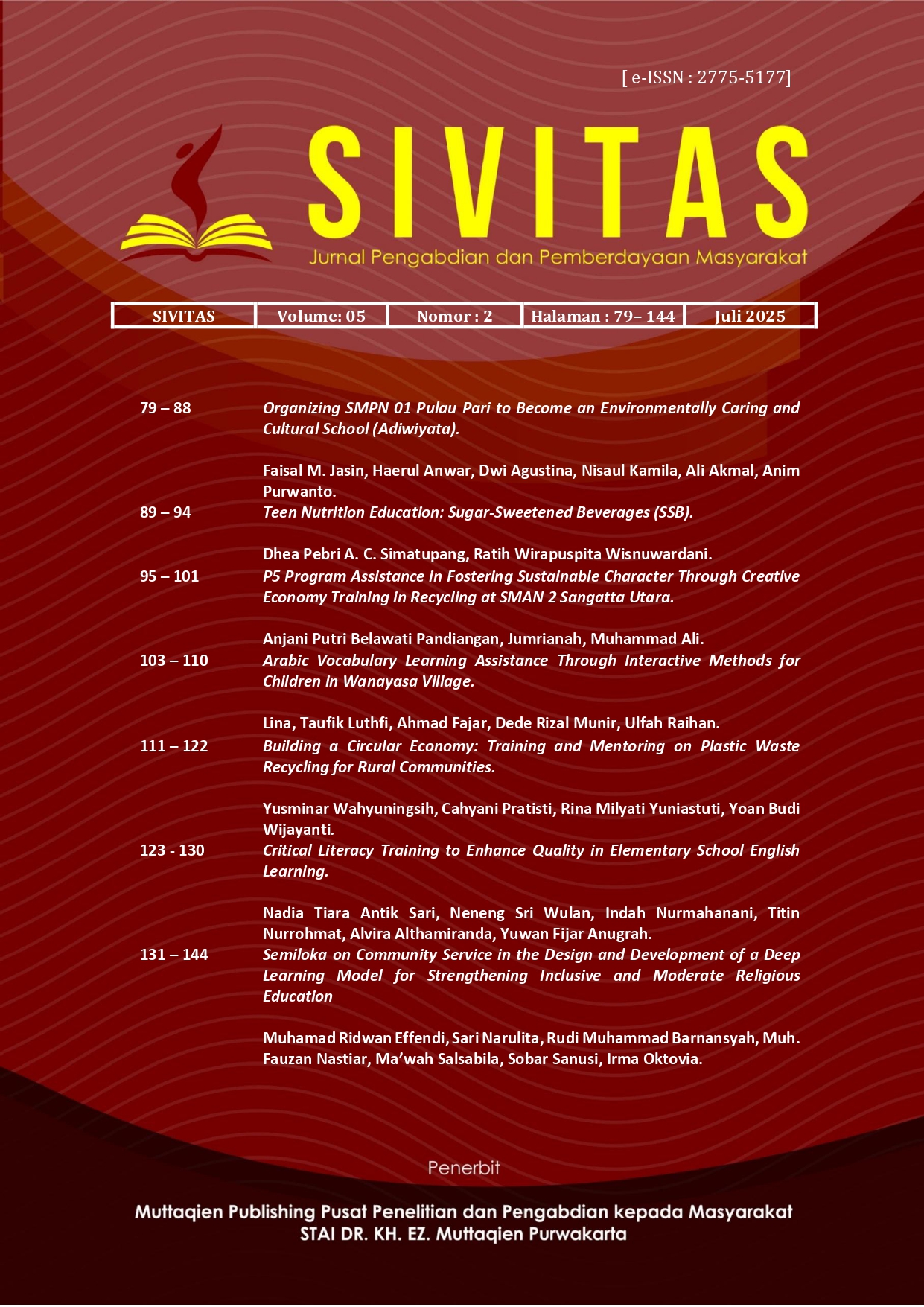Arabic Vocabulary Learning Assistance through Interactive Methods for Children in Wanayasa Village
Keywords:
Children, Arabic Language, Interactive MethodsAbstract
This study aims to develop an effective method for teaching Arabic vocabulary to children in Wanayasa Village using an interactive approach. The research focuses on the use of media such as songs, flashcards, and educational games to improve students' understanding and interest in learning Arabic. Initial observations revealed that children in Wanayasa Village had limited proficiency in Arabic vocabulary and considered Arabic to be a difficult and boring subject. Therefore, this mentoring program was designed to introduce Arabic vocabulary through engaging activities that encourage active student participation. The results of the study show that the interactive method increased children's involvement in learning, improved their vocabulary comprehension, and changed their perception of Arabic to a more positive one. Evaluations conducted after the mentoring sessions indicate a significant improvement in the mastery of the vocabulary taught. These findings support the theory that varied and enjoyable teaching methods can enhance motivation and learning outcomes, particularly in Arabic language instruction. This study recommends the use of interactive methods as an effective alternative.
References
Abusyairy, K., Yamin, M. and Lestari, N.A. (2020) ‘Hubungan antara kemampuan kosakata dan kemampuan berbicara Bahasa Arab pada siswa SMK Muhammadiyah Loa Janan’, EDUCASIA: Jurnal Pendidikan, Pengajaran, dan Pembelajaran, 5(3), pp. 131–144.
Achoita, A. and Susanti, J.S. (2020) ‘Pengaruh Penguasaan Kosa Kata Terhadap Kemampuan Menulis Bahasa Arab Siswa Kelas Viii Mts Assalam Bangilan Tuban Tahun Pelajaran 2019/2020’, Tadris: Jurnal Penelitian dan Pemikiran Pendidikan Islam, 14(1), pp. 19–40.
Basyiroh, L.A. (2024) Pengaruh Media Interaktif Wordwall Terhadap Pemahaman Kosakata Bahasa Arab Pada Peserta Didik MI Darussalam Sidoarjo. Surabaya: UIN Sunan Ampel.
Hariadi et al. (2023) ‘Penerapan Metode Interaktif dalam Meningkatkan Keaktifan Siswa Pada Pembelajaran Penjaskes’, Jurnal Porkes Pendidikan Olahraga Kesehatan dan Rekreasi, 6 Nomor 2, pp. 837–853.
Lina, L. and Munir, D.R. (2023) ‘Penerapan Metode Bernyanyi untuk Meningkatkan Hasil Belajar Mufradat Siswa DTA Baiturrohim Purwakarta’, Kalimatuna: Journal of Arabic Research, 2(1), pp. 25–38.
Mulyani, R. (2024) ‘PENTINGNYA BELAJAR BAHASA ARAB DALAM MEMAHAMI AL-QUR’AN DAN HADITS’, AL-MA’LUMAT: JURNAL ILMU-ILMU KEISLAMAN, 2(1), pp. 33–39.
Nabila, S., Tsania, S.P. and Yusup, R. (2024) ‘Penerapan Metode Interaktif Untuk Meningkatkan Penguasaan Kosa Kata Bahasa Inggris Siswa Kelas 5 MI Cirenged Kabupaten Sukabumi’, Journal of Management Education Social Sciences Information and Religion, 1(2), pp. 545–551.
Qomarudin, M., Pratama, H. and Nuriyah, S. (2024) ‘Pengaruh Penggunaan Media Flash Card Terhadap Kemampuan Menghafal Kosa Kata Bahasa Arab Kelas IV di MI Se Kecamatan Bumi Agung Way Kanan’, Al-I’tibar: Jurnal Pendidikan Islam, 11(3), pp. 227–231
Published
How to Cite
Issue
Section
Copyright (c) 2025 Lina Lina, Taufik Luthfi, Ahmad Fajar, Dede Rizal Munir, Ulfah Raihan

This work is licensed under a Creative Commons Attribution-ShareAlike 4.0 International License.
SIVITAS: Jurnal Pengabdian dan Pemberdayaan Masyarakat allow the author(s) to hold the copyright without restrictions and allow the author(s) to retain publishing rights without restrictions and authors who publish with this journal agree to the following terms:
In developing strategy and setting priorities, SIVITAS: Jurnal Pengabdian dan Pemberdayaan Masyarakat recognize that free access is better than priced access, libre access is better than free access, and libre under CC-BY-SA or the equivalent is better than libre under more restrictive open licenses. We should achieve what we can when we can. We should not delay achieving free in order to achieve libre, and we should not stop with free when we can achieve libre.
SIVITAS: Jurnal Pengabdian dan Pemberdayaan Masyarakat has a CC-BY SA license or its equivalent as the optimal license for publication, distribution, use and reuse of scientific work. This license is under a Creative Commons Attribution 4.0 International License.
You are free to:
- Share — copy and redistribute the material in any medium or format
- Adapt — remix, transform, and build upon the material for any purpose, even commercially.
- The licensor cannot revoke these freedoms as long as you follow the license terms.











